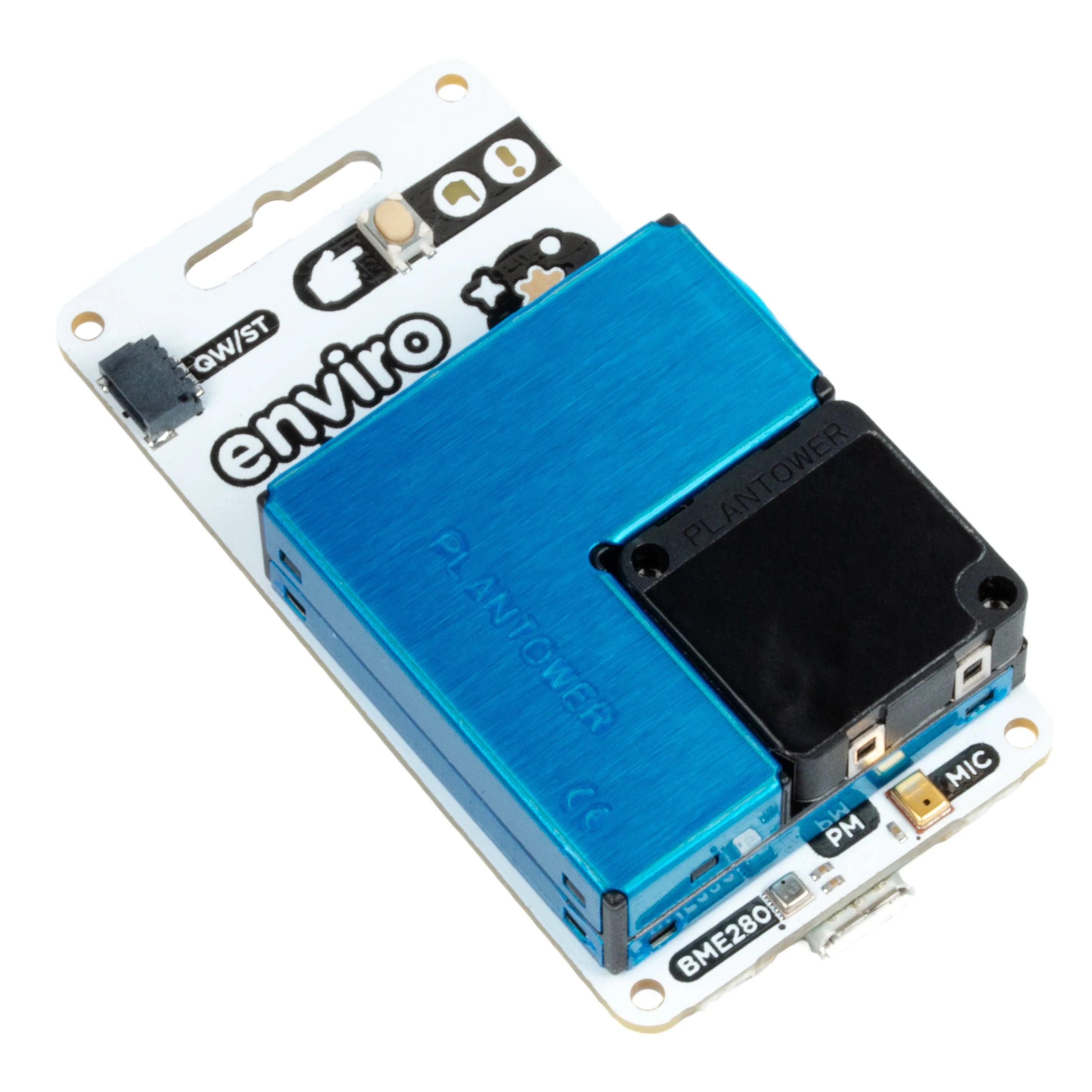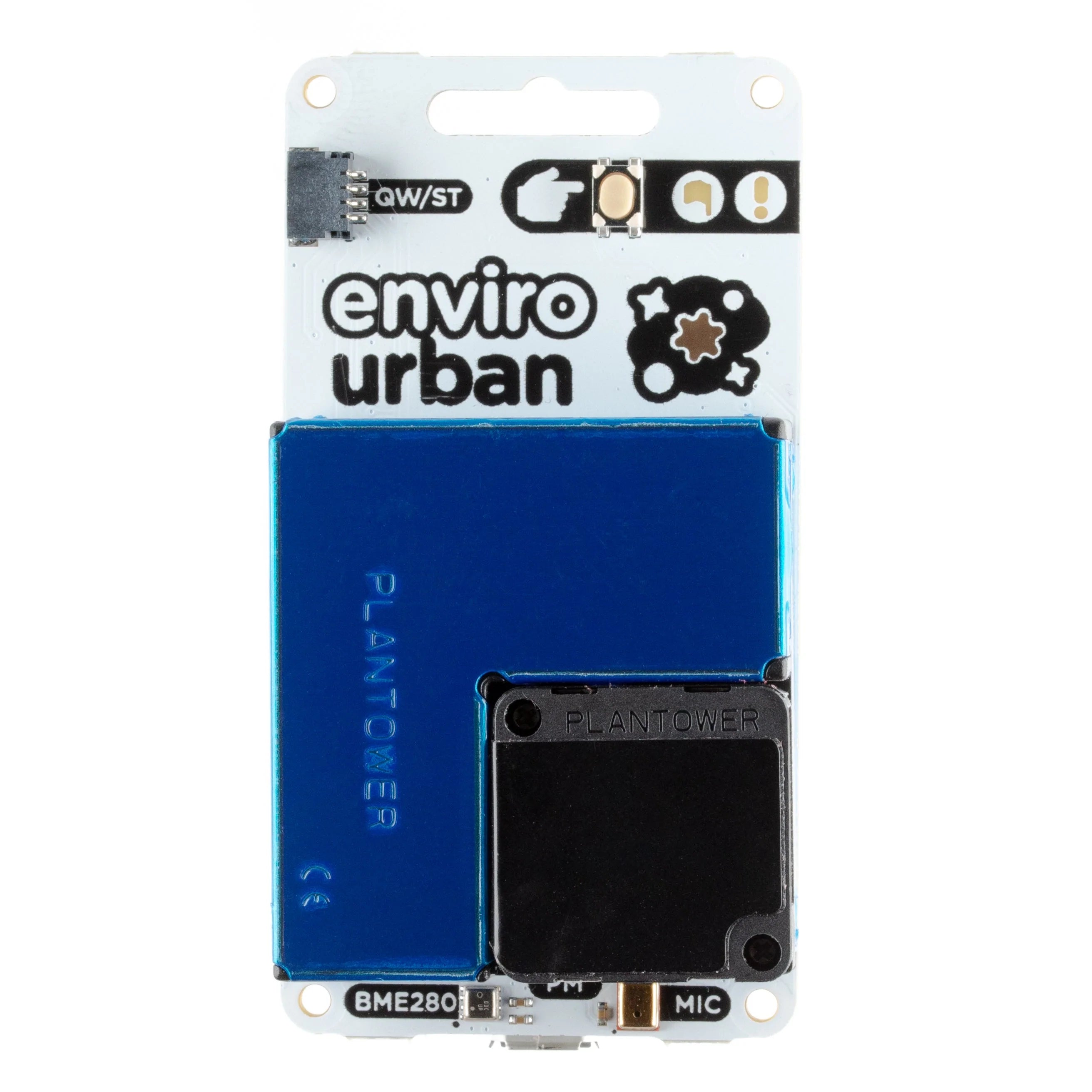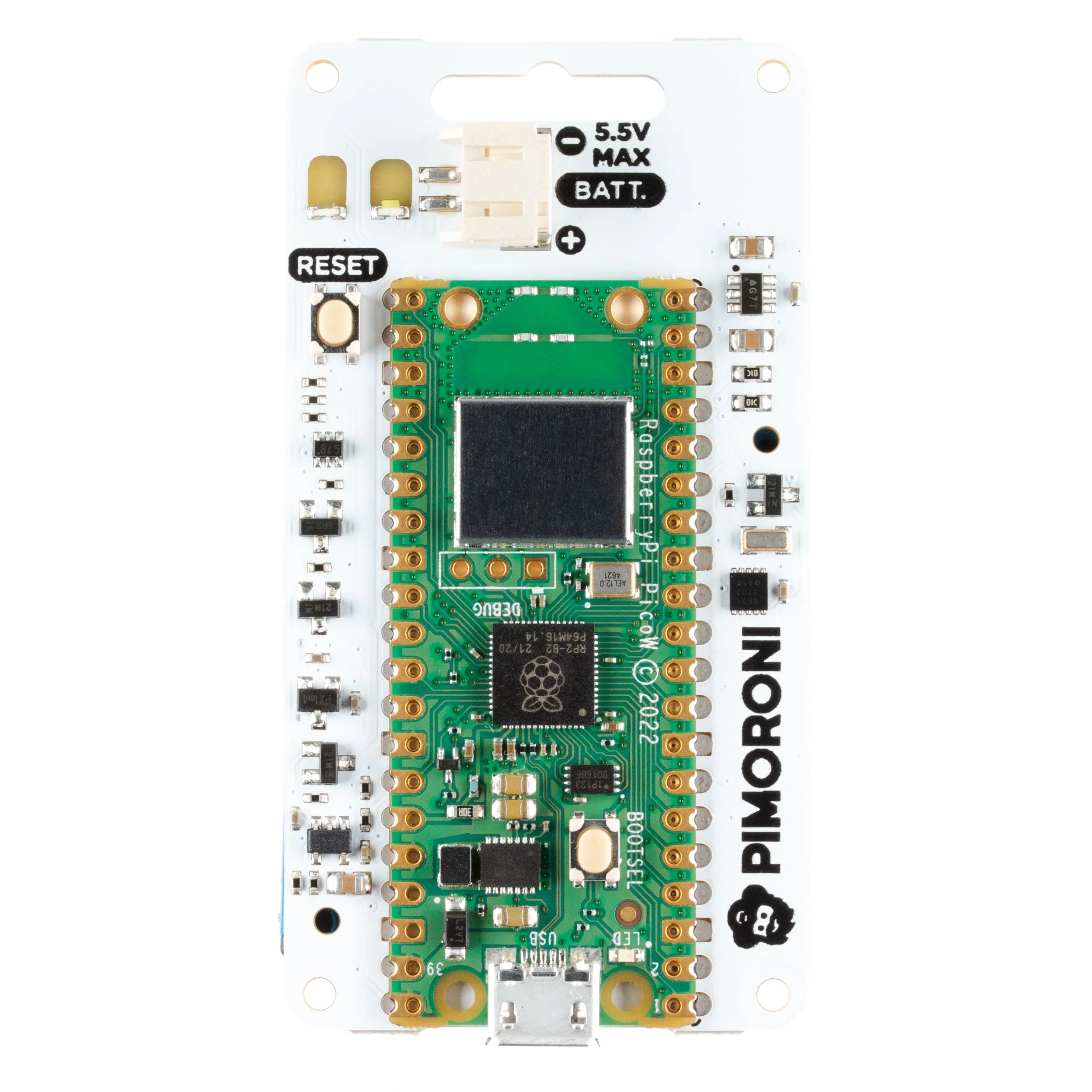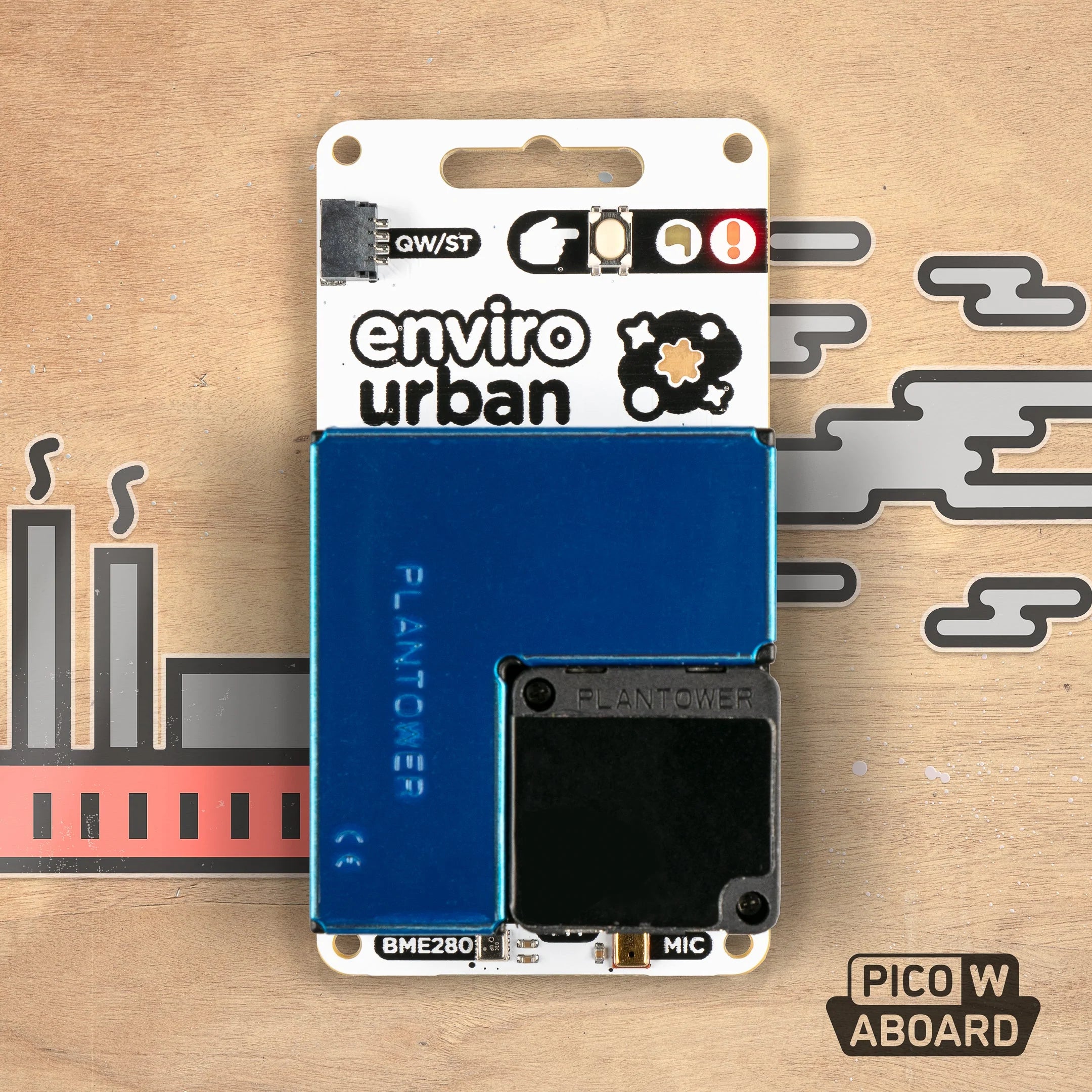Ein drahtloses Board zur Überwachung der Luftqualität im Freien mit Umwelt- und Partikelsensoren und einem Mikrofon.
Enviro Urban ist ein All-in-One-Board zur Überprüfung aller in der Luft befindlichen Schadstoffe, die in bebauten Gebieten auftreten können. Es gibt einen BME280-Sensor für die Messung Temperatur, Feuchtigkeit und Druck, a Mikrofon zur Lärmüberwachung und ein vorinstalliertes PMS5003I Partikelsensor. Feinstaub besteht aus winzigen Partikeln unterschiedlicher Größe und Art, wie Staub, Pollen, Schimmelpilzsporen, Rauchpartikel, organische Partikel und Metallionen und vieles mehr. Feinstaub macht einen Großteil dessen aus, was wir als Luftverschmutzung bezeichnen.
Sammeln Sie Daten in einer Datenbank (z. B. InfluxDB), um sich für saubere Luft in Ihrer Region einzusetzen, oder nutzen Sie die drahtlosen Funktionen des Raspberry Pi Pico W, um zu Citizen-Science-Projekten beizutragen wie sensor.community.
Sie können einen Enviro Urban allein oder in einem Set kaufen, das ein wetterfestes Gehäuse und alles, was Sie sonst noch brauchen, um loszulegen.
Enviro x Peak W Aboard
Pimoronis neue Produktreihe Enviro (Pico W Aboard) wurde entwickelt mit Umweltüberwachung / Protokollierung im Sinn. Pimoroni wollte eine Reihe von Pico/RP2040-betriebenen All-in-One-Sensorplatinen entwickeln, die kompakt, leicht zu installieren und einfach zu programmieren sind. Die drahtlose Fähigkeit des Raspberry Pi Pico W ermöglicht die Integration von Enviro in andere Systeme - so können Sie Ihre Daten in Datenbanken, Hausautomatisierungssysteme oder Online-Wissenschaftsprojekte einspeisen - das Internet ist Ihr Hummer!
Da es am wenigsten Spaß macht, eine Vielzahl von Sensoren in Ihre Umgebung einzubauen, müssen Sie herausfinden, wie Sie alles mit Strom versorgen können, ohne Unmengen von Kabeln zu verlegen. Batteriestrom . Jedes Enviro-Board verfügt über eine eingebaute RTC (Real Time Clock), so dass es regelmäßig aus dem Tiefschlaf erwacht, eine Messung vornimmt (und optional eine WLAN-Verbindung herstellt) und dann wieder in den Schlafmodus übergeht - so können Sie monatelang ohne Unterbrechung arbeiten.
Außerdem hat Pimoroni für ihre Enviro-Boards einige praktische Zubehör-Kits zusammengestellt, die ein AA- oder AAA-Batteriepaket in passender Größe, ein USB-Kabel und andere wichtige Teile für jedes Board enthalten, damit Sie schnell loslegen können.
Enviro Merkmale
- Raspberry Pi Pico W an Bord
- Dual Arm Cortex M0+ mit bis zu 133Mhz und 264kB SRAM
- 2 MB QSPI-Flash mit Unterstützung für XiP
- Stromversorgung und Programmierung über USB micro-B
- 2.4GHz drahtlos
- Tiefschlaf-/Weckfunktion mit RTC
- 1 x POKE-Taste (Benutzer)
- Reset-Taste (weil wir keine Monster sind)
- Batterieanschluss (JST-PH-Anschluss, 5,5 V maximale Spannung)
- Benutzer-/Aktivitäts-LED (dimmbar über PWM, kann nur leuchten, wenn das Board wach ist)
- Warn-LED (an der RTC angebracht)
- Qw/ST-Stecker für den Anschluss von Breakouts
- Vollständig montiert
- Kein Löten erforderlich.
- Enviro-Firmware
- Schematische Darstellung (in Kürze)
Enviro Urban Merkmale
- BME280 Temperatur-, Druck- und Feuchtigkeitssensor ( datenblatt )
- MEMS-Mikrofon ( datenblatt )
- PMSA003I Feinstaubsensor ( datenblatt )
Enviro Urban + Accessory Kit enthält
- Enviro Urban
-
Wetterfeste Abdeckung/Stevenson-Schirm
- 3 x AA-Batteriepack
- 3 x AA-Batterien
- USB-Micro-B-Kabel
- Klettverschluss zum Befestigen des Akkupacks
Software
Enviro wird mit einer ausgeklügelten Software geliefert, die das Einrichten und Verbinden wirklich einfach macht, selbst wenn es Ihr erster Ausflug in die Umweltaufzeichnung/IoT ist. Schalten Sie ihn ein und verbinden Sie sich mit Ihrem Telefon, Tablet oder einem anderen WLAN-fähigen Gerät mit dem Netzwerk namens "Enviro Urban Setup" - Ihr Pico W wird Sie durch den Rest führen!
Verbinden von Breakouts
Die Qw/ST-Anschlüsse auf den Enviro-Boards machen es sehr einfach, I2C anzuschließen. Qwiic oder QT STEM Breakouts. Wenn Ihr Breakout einen QW/ST-Anschluss auf der Platine hat, können Sie es direkt mit einem JST-SH auf JST-SH Kabel .
Breakout Garden-Breakouts, die nicht über einen Qw/ST-Anschluss verfügen, können mit einem JST-SH auf JST-SH Kabel mehr a Qw/ST auf Breakout-Garden-Adapter . Möchten Sie mehrere Breakouts gleichzeitig verwenden? Versuchen Sie dieser Adapter !
- Liste der Ausbrüche derzeit kompatibel mit unserem C++/MicroPython-Build.
Anmerkungen
- Abmessungen: 69 x 36 mm (L x B, ca.)
- Enviro-Tafeln können eine Tiefschlaf Modus, in dem der Pico W, die Sensoren auf der Karte und die über Qw/ST angeschlossenen Sensoren vollständig abgeschaltet sind. Das einzige, was auf dem Board noch läuft, ist die RTC, die das Board zu einem bestimmten Datum und einer bestimmten Uhrzeit oder über einen Timer wieder aufwecken kann. Sie können das Board auch über die POKE-Taste oder durch Anschließen des USB-Kabels aufwecken (das Board wird niemals schlafen, wenn es an den USB-Strom angeschlossen ist). Der Stromverbrauch im Ruhezustand beträgt 20uA.
- Die RTC kann auch verwendet werden, um die Uhrzeit und das Datum zu verfolgen (was bedeutet, dass wir nicht jedes Mal, wenn wir einen Sensormesswert aufzeichnen, einen drahtlosen Anruf tätigen müssen, um die Uhrzeit/das Datum zu erfahren!)
- Die Warn-LED ist mit der RTC verbunden, so dass sie auch im Tiefschlaf leuchten kann, um Sie über Probleme zu informieren. Sie ist auf drei Zustände beschränkt - an, aus oder 1hz blinken (die Helligkeit kann nicht gesteuert werden).
- Pimoroni empfiehlt die Verwendung eines 3 x AA-Batteriepack mit Enviro Urban, da der Partikelsensor ziemlich viel Strom verbraucht. Jede Batterie, die zwischen 2 V und 5,5 V liefern kann, wird funktionieren - 2 oder 3 alkalische AA- oder AAA-Zellen, 4 wiederaufladbare NiMH-Zellen oder ein einzelliger LiPo. Wenn Sie einen LiPo verwenden, denken Sie daran, dass die Enviro-Boards nicht über ein Ladegerät verfügen, Sie benötigen also ein separates LiPo-Ladegerät (z. B. ein LiPo-Amigo ), um es aufladen zu können.
Über Pico W Aboard
Pimoronis neue Pico W Aboard-Produkte werden mit einem eingebauter Raspberry Pi Pico W . Das bedeutet, dass Sie alle Vorteile eines RP2040-Mikrocontrollers erhalten - einen schnellen Dual-Core-ARM-Prozessor, ein dynamisches, wachsendes Ökosystem und eine Auswahl an verschiedenen Programmiermethoden, mit denen Sie experimentieren können. Am aufregendsten ist jedoch, dass der Pico W drahtlose Konnektivität damit Ihre Pico/RP2040-Geräte miteinander und mit dem Internet kommunizieren können! 🌍
Wireless ist für Pico/RP2040 sehr neu - seien Sie sich bewusst, dass sich die Dinge schnell entwickeln und ändern werden! Die Software-Unterstützung (Wireless-Beispiele, Tutorials, CircuitPython-Unterstützung usw.) wird eine Weile brauchen, um aufzuholen. Wenn Sie ein absoluter Anfänger in Sachen Pico/RP2040 sind, werden Sie vielleicht bessere Erfahrungen mit Wireless machen, wenn Sie warten, bis sich alles ein wenig eingespielt hat.
English Description
A wireless outdoor air quality monitoring board with environmental and particulate sensors and a microphone.
Enviro Urban is an all in one board for checking up on all the airborne nasties that can occur in built up areas. There's a BME280 sensor for measuring temperature, humidity, and pressure, a microphone for noise monitoring and a pre-installed PMS5003I particulate sensor. Particulate matter is made up of tiny particles that are a mix of sizes and types, like dust, pollen, mould spores, smoke particles, organic particles and metal ions, and more. Particulates are much of what we think of as air pollution.
Accumulate data in a database (we like InfluxDB) to campaign for cleaner air in your area, or use the wireless capabilities of the Raspberry Pi Pico W to contribute to citizen science projects like sensor.community.
You can buy an Enviro Urban on its own, or in a kit that includes a weatherproof enclosure and everything else you'll need to get started.
Enviro x Pico W Aboard
Pimoronis new Enviro (Pico W Aboard) range is designed with environmental monitoring / logging in mind. Pimoroni wanted to make a range of Pico/RP2040-powered, all-in-one sensor boards that are compact, easy to install in places and straightforward to program. The wireless capability of Raspberry Pi Pico W lets Enviro integrate with other systems - so you could post your data into databases, home automation systems, or online citizen science efforts - the Internet's your lobster!
Because the least fun thing about adding lots of sensors to your environment is figuring out how supply power to everything without tons of trailing wires, they are all designed to work well off battery power. Each Enviro board has an onboard RTC (Real Time Clock), so that they can periodically wake up from deep sleep, take a reading (and, optionally, connect to wifi) and then go back to sleep - giving you months of untethered battery life.
Pimoroni has also put together some handy accessory kits to go with our Enviro boards, that include an appropriately sized AA or AAA battery pack, a USB cable and other essentials for each board, so you can get going super quick.
Enviro Features
- Raspberry Pi Pico W Aboard
- Dual Arm Cortex M0+ running at up to 133Mhz with 264kB of SRAM
- 2MB of QSPI flash supporting XiP
- Powered and programmable by USB micro-B
- 2.4GHz wireless
- Deep sleep/wake function using RTC
- 1 x POKE (user) button
- Reset button (because we're not monsters)
- Battery connector (JST-PH connector, 5.5V max voltage)
- User/activity LED (dimmable via PWM, can only be lit when board is awake)
- Warn LED (attached to RTC)
- Qw/ST connector for attaching breakouts
- Fully assembled
- No soldering required.
- Enviro firmware
- Schematic (coming soon)
Enviro Urban Features
- BME280 temperature, pressure, humidity sensor (datasheet)
- MEMS microphone (datasheet)
- PMSA003I particulate matter sensor (datasheet)
Enviro Urban + Accessory Kit Includes
- Enviro Urban
-
Weatherproof cover/Stevenson screen
- 3 x AA battery pack
- 3 x AA batteries
- USB micro-B cable
- Velcro for attaching the battery pack
Software
Enviro ships with some super slick provisioning software that makes it really easy to set it up and connect to things, even if it's your first foray into environmental logging/IoT. Power it up and connect to the network called 'Enviro Urban Setup' with your phone, tablet or other wi-fi enabled device - your Pico W will walk you through the rest!
Connecting Breakouts
The Qw/ST connectors on Enviro boards make it super easy to connect up I2C Qwiic or STEMMA QT breakouts. If your breakout has a QW/ST connector on board, you can plug it straight in with a JST-SH to JST-SH cable.
Breakout Garden breakouts that don't have a Qw/ST connector can be connected using a JST-SH to JST-SH cable plus a Qw/ST to Breakout Garden adaptor. Want to use multiple breakouts at the same time? Try this adaptor!
- List of breakouts currently compatible with our C++/MicroPython build.
Notes
- Measurements: 69 x 36 mm (L x W, approx)
- Enviro boards can enter a deep sleep mode where the Pico W, on board sensors and sensors connected via Qw/ST are completely powered down. The only thing left running on the board is the RTC which can wake up the board again at a set date and time or on a timer. You can also wake up the board via the POKE button, or by connecting the USB cable (the board will never sleep if connected to USB power). Power consumption when asleep is 20uA.
- The RTC can also be used to keep track of the time and date (which means we don't need to waste power by making a wireless call to find out the time/date each time we log a sensor reading!)
- The Warn LED is connected to the RTC, so it can be lit even during deep sleep to notify you of problems. It is limited to three states - on, off, or 1hz blink (it's not possible to control the brightness).
- Pimoroni would recommend using a 3 x AA battery pack with Enviro Urban as the particulate sensor uses quite a lot of power. Any battery pack that can supply between 2V and 5.5V will (work though - 2 or 3 alkaline AA or AAA cells, 4 rechargeable NiMH cells or a single cell LiPo. If you're using a LiPo, bear in mind there's no battery charging included on Enviro boards, so you'll need a separate LiPo battery charger (like a LiPo Amigo) to be able to charge it.
About Pico W Aboard
Pimoronis new Pico W Aboard products come with a built in Raspberry Pi Pico W. This means you get all the advantages of a RP2040 microcontroller - a speedy fast dual-core ARM processor, a dynamic, growing ecosystem and a choice of different programming methods to experiment with. Most excitingly though, Pico W has wireless connectivity, so your Pico/RP2040 devices can communicate with each other, and the internet!
Wireless is very new to Pico/RP2040 - be aware that things will move fast and change! Software support (wireless examples, tutorials, CircuitPython support etc) will take a little while to catch up. If you're an absolute beginner to Pico/RP2040, you might have a better experience with wireless if you wait until everything is a little more settled.
Sicherheitsangaben
- Lesen Sie die Bedienungsanleitung sorgfältig durch, bevor Sie das Produkt verwenden.
- Stellen Sie sicher, dass alle Montage- und Installationsanweisungen des Herstellers sorgfältig befolgt werden.
- Verwenden Sie das Produkt nur für den vorgesehenen Zweck.
- Die unsachgemäße Nutzung dieses Produkts kann zu schweren Verletzungen oder Sachschäden führen.
- Nicht für Kinder unter 10 Jahren geeignet.
- Bei unsachgemäßer Verwendung besteht eine Verletzungsgefahr.
- Dieses Produkt entspricht den geltenden Sicherheitsanforderungen der Europäischen Union.
- Dieses Produkt wurde gemäß der GPSR geprüft, die sicherstellt, dass alle relevanten Sicherheitsanforderungen für Konsumgüter eingehalten werden.
Nachverfolgbarkeitsinformationen
Jedes Produkt verfügt über eines oder mehrere der folgenden Merkmale:
- Ein CE-Kennzeichen, das die Einhaltung der Sicherheits-, Gesundheits- und Umweltschutzanforderungen der Europäischen Union anzeigt.
- Eine eindeutige Serien- oder Chargennummer, um die Nachverfolgbarkeit zu gewährleisten und bei Bedarf Rückrufaktionen zu unterstützen.
- Hersteller- und Importeurangaben für den Kundensupport und Sicherheitsanfragen.
Überwachung und Berichterstattung von Vorfällen
Für den unwahrscheinlichen Fall eines Produktproblems haben wir Verfahren implementiert, um:
- Kundenbeschwerden zeitnah bearbeiten.
- Schwerwiegende Vorfälle über das EU Safety Gate/RAPEX-System melden.
- Mit den Marktüberwachungsbehörden zusammenarbeiten, um die öffentliche Sicherheit zu gewährleisten.
Kontakt:
- Email: support [@] pi3g.com
- Telefon: 0341 / 392 858 40
Dieses Produkt ist vollständig mit allen geltenden EU-Vorschriften konform, um die Sicherheit unserer geschätzten Kunden zu gewährleisten.




